 Plantar Fasciitis & The Pain In Your Foot
Plantar Fasciitis & The Pain In Your Foot
When it comes to any injury I believe in four things: Diagnose, educate, and implement; and change.
Healing plantar fasciitis requires making some basic changes. Changes to the way you stand, the way you walk, and the way you think.
In this post, I will introduce you to the hows and whys of plantar fasciitis and provide insight into what it will take to get past this troubling condition.
As you know plantar fasciitis is a pain in the foot, most often in the heel, and affects almost 1 in 10 people at some point in their lifetime.
That’s a lot of people.
If you are one of them you know how debilitating this pain can be, and like many sufferers with plantar fasciitis, you might dread getting out of bed in the morning for fear of the pain that’s coming.
That pain often goes away after walking around for a few minutes but who wants to wake up worrying about the first five minutes of the day?
The painful truth is you might be one of those people who suffer from plantar fasciitis all day long.
To be honest many people who get plantar fasciitis often see it resolve in due time and without medical intervention.
But if you don’t deal with the underlying cause of this miserable condition it might return, and you also might be one of those poor souls (or soles) who have it for years with no resolve.
Traditional solutions like stretching, icing, and even for some, shoe inserts— which I hate— can help many cases resolve fairly quickly and easily.
But that’s not why you are here.
You are reading this because you are likely one of those people who can’t figure out how to get rid of this stubborn pain that is getting in the way of you living your life in a carefree and easy way.
The plantar fascia which I’ll describe in more detail below is extraordinary and it is shocking just how much force it absorbs over a single day.
Anytime you stand, walk, run, or even sit, the plantar fascia is involved, and if your feet aren’t well aligned and working successfully the strain can and will take its toll.
One crazy thing about plantar fasciitis is how many people who come to me with this condition report that podiatrists, other doctors, or physical therapists tell them they should never go barefoot again.
What in the world?
We are born barefoot and we darned well should be able to walk barefoot as well.
I mean, shoes have only been around for about 30,000 years. That means we have been going barefoot a lot longer than we haven’t.
Everyone is susceptible to this awful condition. Athletes especially. And not just weekend warriors. Professionals too.
It isn’t hard to imagine how much of a beating any athlete’s feet can take.
Unfortunately, women are more likely to experience plantar fasciitis than men. This might be related to the shoe choices women make but to be honest I am not so sure about that.
One thing I am sure of is doctors are making a lot of money from people with plantar fasciitis, even though, in my humble opinion, they aren’t the answer.
The answer for me doesn’t lie with doctors, podiatrists, physical therapists, orthotics, sleeping boots, or any other of the many options.
The answer is within you and your willingness to make some simple changes to the way you exercise, stand, and walk.
Plantar fasciitis develops in response to trauma to the plantar fascia and any activity that you don’t do efficiently can lead to plantar fasciitis.
Even standing still!
But as someone who teaches people to walk along with my other techniques, I can promise you that walking poorly can lead to plantar fasciitis.
I can also promise that learning how to walk correctly with some basic changes is the easiest way to relieve your symptoms.
WHAT IS FASCIA?
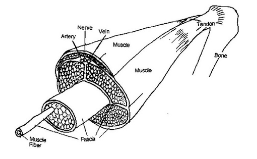
The word fascia comes from Latin, meaning “a band”.
Basically, the body is made of connective tissue that is made up of cells, fibers, and a gel-like substance.
Types of connective tissue include fascia, bone, cartilage, fat, blood, and lymphatic tissue.
Fascia is one of the most important tissues in the body that has only come on the radar of doctors, body workers, and other healthcare professionals in the last couple of decades.
It is a semi-flexible band of connective tissue that wraps around and provides support to your muscles, tendons, ligaments, tissues, organs, nerves, joints, and bones.
It is kind of crazy but everything in the body is wrapped in connective tissue. The entire body itself is wrapped in the subcutaneous fascia that sits just below the skin.
Imagine that muscles are made up of a collection of fibers— as many as 100,000 to a muscle— and each of those fibers is wrapped in fascia.
Muscles are also arranged in groups and every muscle group is wrapped in fascia.
Likewise, every organ is wrapped in fascia.
I think you get the picture. Fascia is everywhere in the body and it couldn’t be more important.
Here are some important fascia facts.
- It holds your muscles together allowing them to contract and stretch.
- It provides a smooth surface for your muscles, joints, and organs to slide against each other without creating any friction or tears.
- It stabilizes your body structures and gives your body strength.
- It separates your muscles and eases muscle tension.
- It helps with joint stability and movement and improves circulation.
- It creates an environment that enables all of your body systems to work together.
When your fascia is healthy, it’s flexible and stretches with you.
When your fascia is unhealthy or tightens up, it can restrict movement and cause painful health conditions such as plantar fasciitis.
WHAT IS THE PLANTAR FASCIA?
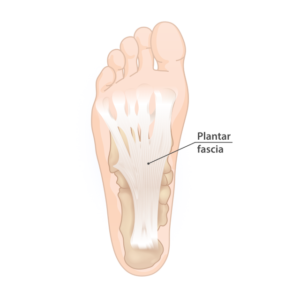
The plantar fascia is a thick band of connective tissue that runs along the sole of the foot from your heel to the base of your toes.
Its job is to support the arch of your foot, absorb stress, and give you the “spring” in your step.
Normal tension or stress in the plantar fascia increases when you place weight on the foot.
The tension also increases when you push off the ball of the foot and toes.
Both of these motions occur during normal walking or running.
WHAT IS PLANTAR FASCIITIS & WHY DO WE GET IT?
The plantar fascia exists to absorb the intense stresses and strains our feet endure when walking, running, playing ball sports, or other activities
Too much pressure or poor mechanics can damage or tear the plantar fascia.
The body’s natural response to injury is inflammation, which results in heel pain and the stiffness that is plantar fasciitis.
Plantar fasciitis (PLAN-tur fas-e-I-tis) is probably the most common cause of heel pain.
Plantar fasciitis commonly causes stabbing pain that often accompanies your first steps in the morning.
The pain normally decreases after a few steps or minutes, but it might return after long periods of standing or when you stand up after sitting. Some people suffer this pain all day long.
Heel spurs are found in about 50% of plantar fasciitis cases at which point we get into a chicken and egg situation. Are heel spurs caused by plantar fasciitis or vice, versa?
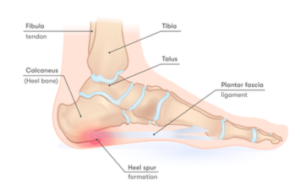
I think heel spurs ( bone spurs are not always a bad thing) are most often caused by the plantar fascia pulling away from the bone due to the stress that leads to plantar fasciitis.
Often referred to as an overuse injury I prefer to see it as a poor-use injury.
Numerous factors can contribute to plantar fasciitis:
- High arches
- Flat feet
- Starting a new activity
- Overdoing a new activity
- Repetitive impact from running or jumping
- Tight calves
- Poor Movement Patterns
THE FOOT

The human foot is extraordinary. There are 206 bones in the human body and a quarter of them are in the feet.
The feet have a number of functions. They bear and transfer weight through the skeleton, act as shock absorbers, and create forward motion.
Each foot has:
- 26 Bones
- 33 Joints
- 42 Muscles
- At least 50 ligaments
The feet are extremely flexible and are designed to both adapt to uneven surfaces and maintain stability.
The feet are the foundation of movement and play an essential role in walking, running, jumping, climbing, dancing… and more.
Each foot has three arches that are essential to posture and movement and function successfully only when the plantar fascia is successfully involved.
THE ARCHES OF THE FOOT
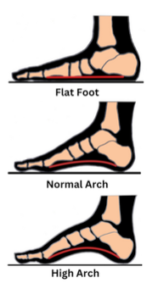 The three arches are:
The three arches are:
- The Inner Arch
- The Outer Arch
- The Transverse Arch
The arches help the feet stand, balance, run, walk, and jump by adding flexibility and spring to the foot.
While the outer and transverse arches are very important when it comes to plantar fasciitis we care most about the inner, or longitudinal arch.
The plantar fascia is a major supporting element of the medial longitudinal arch that also plays a role in shock absorption.
WALKING & THE WINDLASS MECHANISM
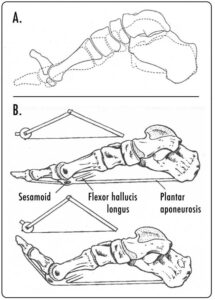
Poor walking patterns can cause and exacerbate plantar fasciitis and conversely, good walking technique is essential to healing it and keeping it from coming back.
The windlass mechanism describes how well-executed movement patterns supercharge the plantar fascia for stability and support.
The term ‘windlass’ comes from sailing. A windlass is a winch mechanism, where a rope is wound and tightened around a drum.
The plantar fascia acts as the rope wound around the drum of the metatarsal heads of the toes.
Tension from the tightening of the plantar fascia maintains the inner arch and prevents the arches from collapsing.
Here’s how it works.
When we push off the big toe the heel is lifted upwards, which bends the toes.
The bent big toes create the winding mechanism increasing tension through the plantar fascia.
Increased tension in the plantar fascia pulls the heel bones closer to the big toes also increasing the height of the inner arch of the foot.
This locks the bones of the inner arch together to provide a solid base of support for the push-off of each step.
And as quickly as the inner arch locks to facilitate the push-off, it unlocks to let the arch drop through its next phase of movement.
When we walk well this is happening thousands of times a day and the plantar fascia is well conditioned for use and age.
When we walk and exercise with poor movement patterns we are asking for trouble with the plantar fascia.
Learning to walk correctly and employ the windlass mechanism with each step is key to getting and staying out of the pain of plantar fasciitis.
One cool thing if you change the way you walk you simply start using this essential mechanism. It isn’t something you need to think about, just something you need to access.
And I promise you it isn’t all that hard to learn how to walk correctly.
THE ARCHES OF THE FOOT
Like I said in the beginning, when it comes to any injury I believe in four things: Diagnose, educate, and implement; and change.
When it comes to plantar fasciitis, I think it is important to understand the role of your foot in your daily life in order to learn what you can and should do to find pain relief and keep plantar fasciitis from returning.
A combination of changes to your posture, the way you walk, and the way you exercise is essential to healing plantar fasciitis and then keeping it at bay.
And once you know how everything works even if it does come back you would have the tools with which to heal it again.
Over the next week or so I will send you more information about the foot and plantar fasciitis so you can become the master of your body’s destiny and heal yourself.

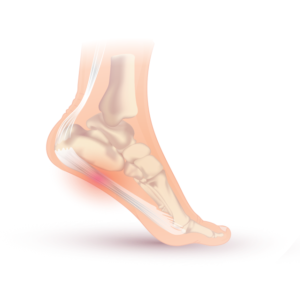 Plantar Fasciitis & The Pain In Your Foot
Plantar Fasciitis & The Pain In Your Foot